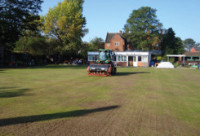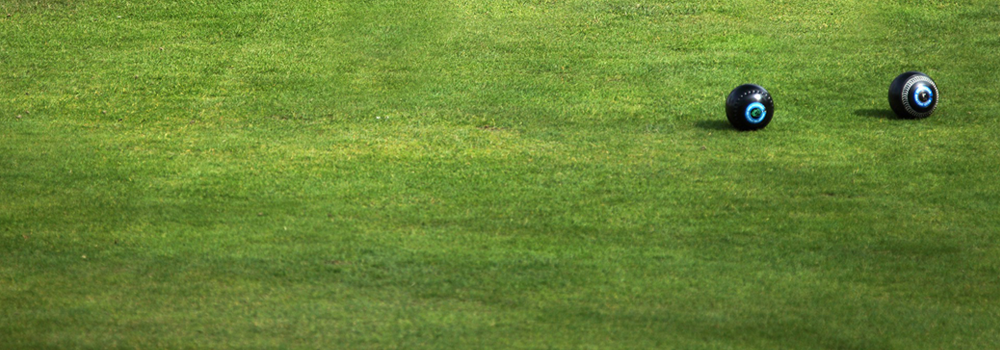If your local conditions are at the drier end of the spectrum, water stress can quickly creep in, especially on windy days when evapotranspiration rates are higher. This is something which represents a particular risk to newly sown seed which may be in the initial stages of early germination and establishment.
Key Tasks for October

- Regular brushing in the mornings to remove the moisture from the leaf is an important maintenance regime to deter an attack of disease.
- Monitor thatch levels and aerate to achieve desired levels of oxygen within the sward.
- Tip the grass when necessary to prevent any excessive growth taking place
- Apply further top-dressing if any holes or hollows require
- Check for disease and pests, seek advice if necessary
- Drag brush daily
- Spike if conditions are right
End of Season Renovations
The success of the renovations will be down to the appropriate work undertaken including:
- Scarification
- Aeration
- Topdressing
- Overseeding
The objectives of end of season renovations are:
- To remove thatch
- To repair worn areas
- To renovate surface levels
- To remove unwanted debris
- To re-establish sward densities (overseeding)
- Application of pre seeding/autumn fertilisers to promote sward establishment
The following activities are usually carried out in the following order, when conditions allow.
Mowing the sward, preparing surfaces for renovation: lower cutting height to about 3-4mm to clean and prepare green for renovation operations.
Scarification, removal of unwanted debris: collect and disposal of arisings. Depending on the severity of the thatch, you may need to scarify several times in different directions and to a depth of 4-15mm.
Aeration will usually be done with solid tines however, occasionally hollow tines will be used if a change of soil texture is required.
Topdressing. Spreading can be achieved by several methods, utilising pedestrian or ride-on, disc or drop action top spreaders, or by hand using a shovel and a barrow. Best carried out in dry weather.
Overseeding. It is important to ensure a good groove or hole is made to receive the seed; good seed to soil contact is essential for seed germination. Good moisture and soil temperatures will see the seed germinate between 7-14 days.
Fertilising. More phosphate and potash is applied during the autumn and winter period to encourage root growth.
Watering/Irrigation is essential after renovations to ensure your seed germinates.
Brushing/switching of the playing surface keeps the green clean and removes any dew or surface water. Keeping the surface dry will aid resistance to disease.




Cooling temperatures, shorter days and longer nights, and heavy dews inextricably lead to reduced recovery growth, fungal pathogens and worm casts. October truly is the middle of Autumn and the steady march towards winter gathers pace. That said, October can still throw up some sunnier and drier spells, not to mention vibrant autumn colour, so all is not lost for the month. It does undoubtedly represent a time of change for turf managers as the plants needs adjust with the environmental conditions.
Nutrition
Accordingly, nutrition geared towards growth should be placed on the back burner. Organic fertilisers are best phased out any time after the start of the month as the release of nitrogen is inhibited once soil temperatures fall below 10 ◦C.
Nitrogen, the key driver for growth, is in much lower demand within the plant and forcing growth with nitrogen has its risks, but it is important to maintain adequate potassium levels.
Traditionally, accepted wisdom has been preventative applications of iron sulphate throughout the autumn and winter. The latest research demonstrates that iron sulphate statistically performs no better than control when used in this manner and, when used curatively, only reduces disease by 40-50%. Furthermore, iron sulphate is acidic and, when applied to the leaf, can actually weaken the cell structure. Phosphite is a much better option to use in this manner and calcium is the element responsible for cell wall thickness, not iron. Hence, we should all be applying calcium in combination with phosphite to effectively guard against disease.
Silicate is utilised by grass plants to provide structural support to cells. When applied as a foliar plant feed, available forms of silicate will accumulate in the secondary cell walls, providing added protection to biotic (pathogen) and abiotic (environmental) stresses.
Aeration
Increasingly, we see greater extremes of weather and the main pressure during autumn across many areas of the country can be heavy rainfall. Aeration ahead of prolonged periods of rain aids percolation rates, which helps to maintain appropriate soil/water ratios and which are important for microorganisms and plants alike. This aeration can take numerous forms, however a mix of deeper aeration from solid or hollow tines will facilitate water movement to deeper depths in the soil profile. This can be combined with frequent shallow sarel tine aeration, just into the surface, which has the benefit of aerating a large percentage of the surface area, aiding initial movement away from the surface.
It goes without saying that, whilst frequent aeration is important during wet conditions, it should only be undertaken when ground conditions allow, so to avoid surface damage and soil compaction.
Maintaining the soil water balance prevents hypoxia (deprivation of oxygen) and black layer due to sulphur metabolising anaerobic bacteria proliferating in low oxygen soils.
Penetrant wetting agents will aid water movement through profiles and are worth considering as another tool in the armoury.
Pest Control

In the case of the insect pests, we are in the second season without chemical controls. Some sites were caught out in spring 2017 due to missing preventative controls in late summer 2016. The control in question is Entomopathogenic nematodes, a natural native predator of the insect pests which have been proven, over many years, to be very effective when applied correctly; i.e. at the right time of the pest life cycle and in conditions conducive to beneficial nematode activity.
The approach to managing pests with biological controls is multifaceted and requires a thoughtful prepared mindset. The Pitchcare articles library and the shop webpages provide a wealth of information on this subject to help you maximise your results.
The control of worms is a significant issue for turf managers, and the withdrawal of Carbendazim for their suppression earlier in the year means that this is the first time we enter the main worm season without any legal means of mitigating their effect. There are a number of products available on the market which are known to have effects on worms in a variety of ways; however, knowledge as to their effects on the environment, the grass plant rhizosphere and wider soil ecosystem are extremely limited to non-existent.
In some circumstances, we may have to consider cultural management combined with tolerance in the form of dispersal when dry, or localised acidification of rootzone surfaces. Consideration of controls which are sustainable in the long term is also important.
There are no easy or perfect answers to this situation, but turf managers should arm themselves with informed knowledge before taking decisions, especially where they feel they are employed by organisations who may not be overly sympathetic should the ultimate outcome of a decision be something unintended.
Disease
Disease management will be at the forefront of turf managers minds across the country. Whilst soil temperatures remain above 10◦C, systemic fungicides are still an option; otherwise, products with a contact action will be required.
Autumn/Winter 2017 is likely to mark the final season turf managers will be able to call upon the eradicative action of products containing the contact active Iprodione. For many years, this has been the go to active ingredient providing eradicative activity of numerous diseases. With this option removed, turf managers have to arm themselves with the knowledge and skills to manage surfaces to prevent against disease. One method in the integrated armoury for achieving this is via plant nutrition. In this regard, the main elements are calcium, phosphite, silicate.
Traditionally, accepted wisdom has been preventative applications of iron sulphate throughout the autumn and winter. The latest research demonstrates that iron sulphate statistically performs no better than control when used in this manner and, when used curatively, only reduces disease by 40-50%. Furthermore, iron sulphate is acidic and, when applied to the leaf, can actually weaken the cell structure. Phosphite is a much better option to use in this manner and calcium is the element responsible for cell wall thickness, not iron. Hence, we should all be applying calcium in combination with phosphite to effectively guard against disease.
Silicate is utilised by grass plants to provide structural support to cells. When applied as a foliar plant feed, available forms of silicate will accumulate in the secondary cell walls, providing added protection to biotic (pathogen) and abiotic (environmental) stresses.
It is important to maintain machines by carrying out regular servicing and repairs.
As grass growth slows down, use the time to take some machines out of operation for an overhaul.
- Inspect and clean machinery after use.
- Maintain a stock of consumables for your machinery, replace worn and damaged parts as necessary.
- Secure machinery nightly with good storage facilities and strong locks
- Record makes and models and take pictures of your equipment as additional reference

Pitchcare is the only provider of LANTRA accredited training courses in the maintenance of Bowls Greens. More information
We can also arrange Lantra accredited training on site to groups of 6 – 10 people. Email Chris Johnson for information.
The Course Manual is available for purchase separately.
Check and inspect ditches, floodlights, structures and any site furniture for damage; keep the site clean and maintain a tidy appearance throughout the facility.
Current Forum discussion: Bowls


